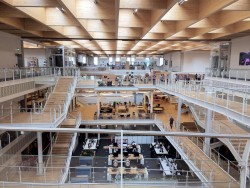As the UK grapples with climate change and the urgent need for more sustainable construction approaches – many developers are in a state of confusion about how to meet the proposed Building Regulation changes to further reduce the combustible restriction on external walls to 11m and achieve sustainability targets. Andy Goodwin, Managing Director for B&K Structures considers the action that is needed now if the construction industry is to have a sustainable future.
At times like these it calls for a considered approach and not knee-jerk reactions. Across all manufacturing industries the goal posts are constantly shifting, we only have to look to the automotive industry and the ban on new diesel and petrol cars in just 15 years to witness the impact of changing regulations.
Quality, safety and sustainability are at the heart of our operation. Buildings are the sum of many parts and by carefully considering every element – the proposed new Building Regulations can be achieved together with sustainability targets. Many, including me, are claiming it is entirely wrong for the Housing Department to include cross laminated timber (CLT) in the same category as highly combustible panelised facade systems and there are robust arguments to support this.
However, we can only deal with the current situation and as a great advocate of engineered timber technology, we must find a way forward. When it comes to carbon sequestration, CLT is a clear and obvious winner over other building materials, especially concrete and steel, and together with the drive toward 2050 zero carbon targets – CLT is a formidable contender in the battle for lower carbon emissions.
Rather than a challenge we see this as an opportunity for B&K Structures. We started out as a specialist steel contractor and this experience combined with our expert knowledge in engineered timber technology means we are well placed to design hybrid structures that maximise the benefits of cross laminated timber panels, glulam beams and steel framing systems.
Building physics is complex but there is one simple equation – through CLT and the obvious weight advantages over steel and concrete, lighter equals more sustainable. Reducing the weight of a building lessens the amount of concrete required in the foundations. Using lightweight unitised panelised steel framing systems complete with A1 non-combustible boards for external walls, will reduce weight and remain within the Building Regulations. Internal walls and floors can then be developed from lightweight sustainable and robust cross laminated timber panels. This lean and green approach meets the criteria laid out in the proposed new Building Regulations and achieves sustainability targets.
As the world learns how to deal with extreme weather events believe that it is essential to take preventative steps to reduce the carbon emissions that we all know contribute to this climate emergency, as well as making sure that buildings can stand up to the rigors of extreme weather events.
I am confident that cross laminated timber, as the most sustainable of structural solutions has a role to play in creating buildings that are both safe and sustainable. It is worth mentioning that cross laminated timber has not been involved in any of the recent tragic fires, which we are now learning were as a result of multiple failings of incorrect specification of materials and poor build quality.
According to the European Energy Centre, existing buildings use around 40% of global energy, whilst they produce approximately 33% of carbon emissions. As much as 40% of landfill waste comes from unused building materials. So, we are at a tipping point – unprecedented action is needed now if the construction industry is to have a sustainable future.
Carbon sequestration is our ally in the battle to overcome the environmental impact of construction. Trees and well-managed woodlands play an important role in the removal of carbon dioxide from our atmosphere. Through the biochemical process of photosynthesis carbon dioxide is taken in by trees and stored as carbon which remains ‘locked’ in the timber after processing for use in construction.
Only now are we truly realising the full capabilities of this strong, sustainable and technically advanced structural solution and the new regulations will not stifle innovation. The UK has a magnificent heritage of timber architecture dating back to the thirteenth century – we are now building on this legacy using ground-breaking engineered timber systems. We develop high quality, low carbon projects for a wide range of clients throughout the UK and through our robust, integrated supply-chain, we are dedicated to finding the best sustainable solution.
Operating since 1974, B&K Structures has worked with some of the UK’s renowned clients to develop outstanding buildings with green credentials. For more information on their product portfolio and full range of services go to: www.bkstructures.co.uk
To view the article and the complete magazine please follow this link: https://issuu.com/radarcommunications/docs/offsite_mag_issue_22_web/48?e=15424601/64704172









